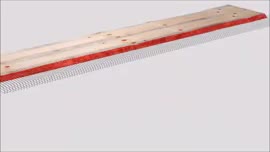Flitch Vision Optimization X Optimization & Controls: Optimizers, controls, operator's consoles, etc. Click on Links Below for Detailed Info.
Functional Description: Optimization is utilized in sawmills, planer mills and plywood plants to extract the maximum value from the fibre. The main types of optimization are bucking, primary breakdown (canter, sharp chain, headrig), edger, trimmer, planer grader, lathe, veneer clipper, veneer patching, panel patching. The scan data (geometric and visual)is transmitted to an optimization computer where the optimum solution is determined. The optimum solution is then sent to the programmable logic controller (PLC) which operates the equipment to implement the solution. Bucking Optimizer: Log or stem merchandizing uses bucking optimizers to determine the most valuable bucking solution. The stems are scanned with lineal or transverse scanning systems for size, shape and visual defects. The gates and saws are positioned to produce the optimum log or block lengths Canter Optimizer: Canters and sharp chain systems use sawing solution optimizers to determine the most valuable sawing solution. The logs, or blocks, are scanned with lineal or transverse scanning systems for size, shape and visual defects. The log turner, infeed, chipping heads and saws are positioned to produce the optimum flitches, boards and cants. Headrig Optimizer: Headrig and carriage systems use sawing solution optimizers to determine the most valuable sawing solution. The logs, or blocks, are scanned with transverse scanning systems for size, shape and visual defects. The carriage bunks are positioned to produce the optimum flitches, boards and cants. Edger Optimizer: Board edgers (saw and chipping) use board solution (edger) optimizers to determine the most valuable edging pattern. The flitches are scanned with transverse or lineal scanning systems for size, shape and visual defects. The infeed and saws are positioned to produce the optimum width boards. Trimmer Optimizer: Trim saw systems use board solution (trimmer) optimizers to determine the most valuable trimming pattern. The boards are scanned with transverse scanning systems for size, shape and visual defects. The fence and saws are positioned to produce the optimum length boards. Planer Grade Optimizer: Automatic grading systems use board grade solution optimizers to determine the most valuable trimming pattern. The boards are scanned with transverse or lineal scanning systems for size, shape and visual defects. The fence and saws are positioned to produce the optimum grade and length finished lumber. The grade and grade stamp are also assigned by the planer grade optimizer Lathe Optimizer: Plywood block peeling systems use plywood solution optimizers to determine the most valuable centering and peeling solution. The blocks are chucked, rotated and scanned for size, shape and visual defects. The lathe charger arms are positioned to produce the optimum grade and volume of veneer. Veneer Optimizer: Veneer clipping systems use veneer optimizers to eliminate defect and grade the veneer. As the veneer feeds through the clipper, the optimizer determines the clip points and activates the clipper. Veneer Patching Optimizer: Veneer patching systems use visual optimizers to detect defects in the veneer. As the veneer feeds through the scanner, defects are identified, removed and replaced with sound material. | ||





